Steve McQueen’s devastating new movie, 12 Years a Slave, begins with the words “based on a true story” and ends with a description of what happened to Solomon Northup and his assailants after he was restored to freedom. What happens in between, as Northup is kidnapped into 12 years of slavery in the South, frequently beggars the imagination. Should you believe even the most incredible details of its story?
With a few rare exceptions, yes. 12 Years a Slave is based on the book of the same name, which was written by Northup with the help of his “amanuensis” and ghostwriter, David Wilson. Aspects of the story’s telling have been questioned by some historians for matching the conventions of the slave narrative genre a little too neatly, but its salient facts were authenticated by the historian Sue Eakin and Joseph Logsdon for their landmark 1968 edition of the book. (They were also reported at the time of the book’s release—in the New York Times and elsewhere.)
As adapted by screenwriter John Ridley from Northup’s book and Eakin and Logsdon’s footnotes, the film adaptation hews very closely to Northup’s telling. While much of the story is condensed, and a few small scenes are invented, nearly all of the most unbelievable details come straight from the book, and many lines are taken verbatim. As Frederick Douglass wrote of the book upon its release in 1853, “Its truth is stranger than fiction.”
Northup in New York
Solomon Northup was the son of Mintus Northup, who was a slave in Rhode Island and New York until his master freed him in his will. Solomon was born a free man and received an unusually good education for a black man of his time, eventually coming to work as a violinist and a carpenter. As in the movie, he was married to Anne Hampton, who was of mixed race, and they had three children—Elizabeth, Margaret, and Alonzo. His wife and children were away when he was offered an unusually profitable gig from his eventual kidnappers, who called themselves Hamilton and Brown.
The movie prefaces its scenes of Northup in New York with a flash-forward that is McQueen and Ridley’s invention: Solomon, while enslaved, turns to find an unidentified woman in bed with him. She grabs his hand and uses it to bring herself to orgasm. McQueen has said of the scene: “I just wanted a bit of tenderness—the idea of this woman reaching out for sexual healing in a way, to quote Marvin Gaye. She takes control of her own body. Then after she’s climaxed, she’s back where she was. She’s back in hell, and that’s when she turns and cries.”
The Kidnappers “Hamilton” and “Brown” (Scoot McNairy and Taran Killam)

Photo still courtesy Fox Searchlight
In his book, Northup refused to say whether Hamilton and Brown were guilty of his kidnapping. He notes that he got extraordinary headaches after having a drink with them one night, and became sick and delirious soon afterward, but cannot conclude with assurety that he was poisoned. “Though suspicions of Brown and Hamilton were not unfrequent,” he writes, “I could not reconcile myself to the idea that they were instrumental to my imprisonment.”
Northup came around to accepting their role in his kidnapping and unlawful sale—an unusual occurrence, but not unique to Northup—soon after the book was published. “Hamilton” and “Brown” weren’t even their real names. A judge, Thaddeus St. John of New York, read the book soon after its release, and realized that he himself had run into the two kidnappers when they were with Northup. Their real names were Alexander Merrill and Joseph Russell, but they asked that St. John, who knew them, not use their real names around Northup. The next time St. John saw them, they had come into some newfound wealth: They carried ivory canes and sported gold watches. Northup and St. John eventually met up, recognized each other immediately, and brought their case against Merrill and Russell. (A note about the case appeared in the New York Times.) Merrill and Russell apparently got off unpunished, after their case was dropped on technicalities.
The Journey Into Slavery

Photo still courtesy Fox Searchlight
The movie’s telling of Northup’s journey into slavery in Louisiana matches Northup’s account almost exactly. Northup says he was beaten with a paddle until the paddle broke, only to be whipped after that, all just for asserting his true identity. We see this in the movie. But an attempted mutiny by Northup and others ends much differently in the film than it does in his own account.
Northup did hatch an elaborate plan to take over a ship with a freeman named Arthur and a slave named Robert (played in the movie by Michael K. Williams). But that plan did not end with Robert coming to the defense of Eliza (Adepero Oduye) against an apparent rape attempt by a sailor, and then being stabbed by that sailor. What foiled their plans was simpler: Robert got smallpox and died.
William Ford (Benedict Cumberbatch)
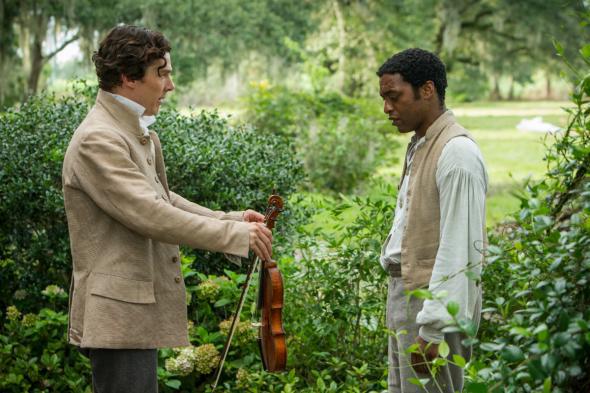
Photo still courtesy Fox Searchlight
Northup gives a more charitable account of his onetime master, William Ford, than the movie does. “There never was a more kind, noble, candid, Christian man than William Ford,” Northup writes, adding that Ford’s circumstances “blinded [Ford] to the inherent wrong at the bottom of the system of Slavery.” The movie, on the other hand, frequently undermines Ford, highlighting his hypocrisy by, for example, overlaying his sermons with the mournful screams of his slave Eliza.
Tibeats (Paul Dano)
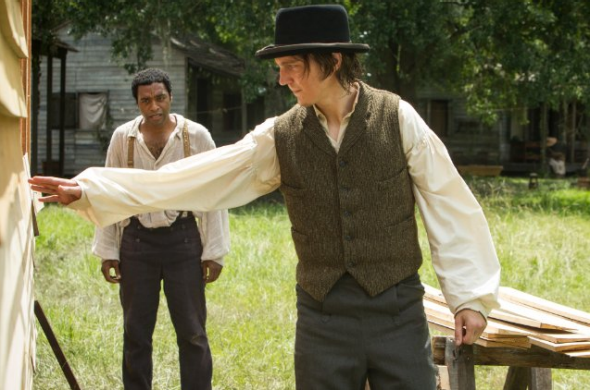
Photo still courtesy Fox Searchlight
Northup actually had two violent encounters with Tibeats. The first scuffle, over a set of nails, is shown in the movie: According to Northup, Tibeats tried to whip him, Northup resisted, and eventually Northup grabbed Tibeats’ whip and beat his aggressor. Afterward, Northup was left bound and on the point of hanging for several hours, before Ford rescued him.
In the book, there is a second brawl over another of Tibeats’ unreasonable demands. According to Northup, he again prevailed, but was afraid of the repercussions, and so this time attempted to run away. Unable to survive on his own in the surrounding swamps, he eventually returned in tatters to Ford, who had mercy on him.
Edwin Epps (Michael Fassbender)

Photo still courtesy Fox Searchlight
Judging from Northup’s book, Epps was even more villainous and repulsive than the movie suggests. In addition to his cruel “dancing moods”—during which he would force the exhausted slaves to dance, screaming “Dance, niggers, dance,” and whipping them if they tried to rest—Epps also had his “whipping moods.” When he would come home drunk and overcome with one of these moods, he would drive the slaves around the yard, whipping them for fun.
There’s another small change. The scene that introduces Epps—his reading of Luke 12:47 as a warning to slaves—is actually borrowed from another of the book’s characters: Ford’s brother-in-law, Peter Tanner. In the movie, Northup’s time with Tanner—with whom he lived after his first fight with Tibeats—is omitted.
Patsey (Lupita Nyong’o)
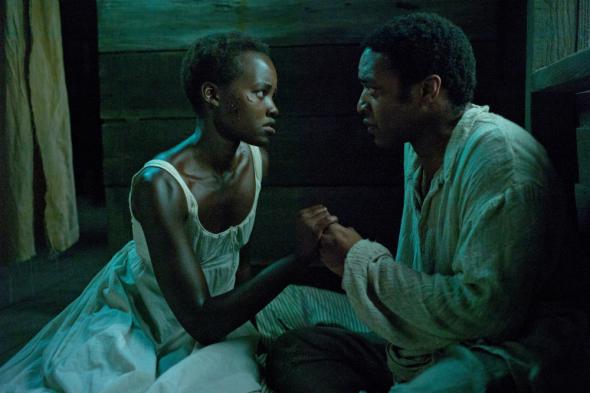
Photo still courtesy Fox Searchlight
Northup does not portray the relationship between Epps and Patsey as explicitly as the movie does, but he does refer to Epps’ “lewd intentions” toward her. As we see in the film, Mistress Epps encourages Master Epps to whip her, out of her own jealousy. This culminates in the horrible whipping shown in the movie, which Northup describes as “the most cruel whipping that ever I was doomed to witness,” saying she was “literally flayed.” Her request afterward that Northup kill her, to put her out of her misery, is the movie’s own invention, but it’s a logical one: Patsey is described as falling into a deep depression and, it’s implied, dreaming of the relief death would offer her.*
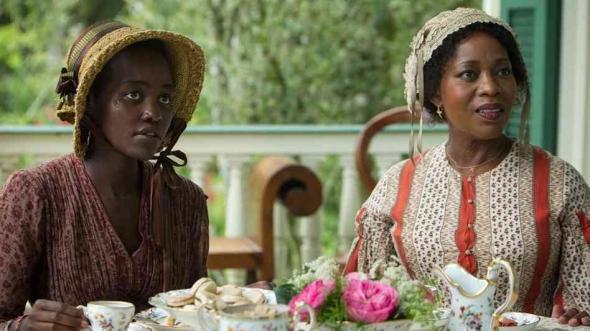
Photo still courtesy Fox Searchlight
Mistress Shaw (Alfre Woodard)
As in the book, Mistress Shaw is the black wife of a plantation owner. However, Patsey’s conversation with Shaw is invented. McQueen and Ridley said they wanted to give Woodard’s character a voice.
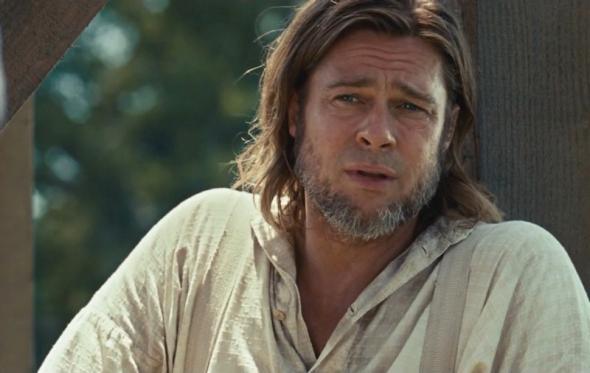
Photo still courtesy Fox Searchlight
Bass (Brad Pitt)
As unlikely as his character is—an abolitionist in Louisiana, and a contrarian who everyone likes—Bass is drawn straight from the book’s account. His argument with Epps (“but begging the law’s pardon, it lies,” “There will be a reckoning yet”) is reproduced almost verbatim.
The real Bass, in fact, did more for Northup, sending multiple letters on his behalf, meeting with him in the middle of the night to hear his story, and—when they initially got no response from their letters—vowing to travel up to New York himself, to secure Northup’s freedom. The process took months, and Northup’s freedom eventually came from Bass’s first letter after all, so the movie understandably chooses to elide all this.
The Return Home
Northup’s return home is much as it is in the book, including Solomon’s learning that his daughter Margaret (who was 7 years old when he last saw her) now had a child of her own, named Solomon Northup. One devastating detail is left out: After 12 years apart, Margaret did not recognize her father.
*Correction, Nov. 4, 2013: This post was corrected to suggest a scene from the movie 12 Years a Slave was drawn from the book. The original article was accurate: Patsey’s plea for Northup to kill her was an invention of the movie. The original language has been restored.